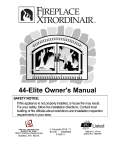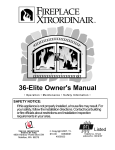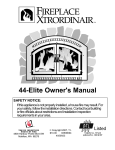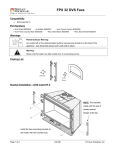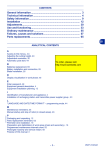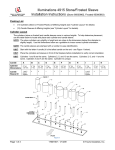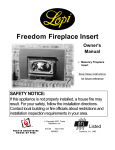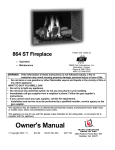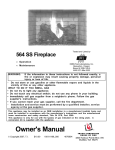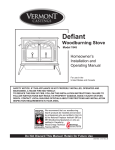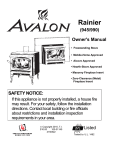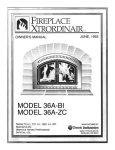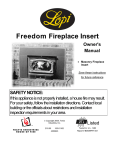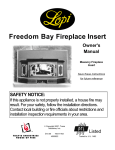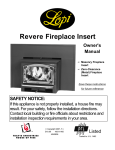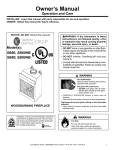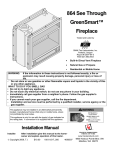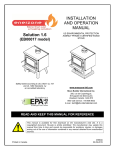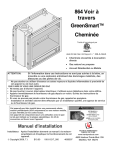Download 36-Elite Owner`s Manual
Transcript
TM 36-Elite Owner's Manual SAFETY NOTICE: If this appliance is not properly installed, a house fire may result. For your safety, follow the installation directions. Contact local building or fire officials about restrictions and installation inspection requirements in your area. 12521 Harbour Reach Drive Mukilteo, WA 98275 Copyright 2015, T.I. $10.00 93508091 4150512 Listed Tested to: U.L. 127 and portions of U.L. 1482 & 907 Introduction 1 Introduction We welcome you as a new owner of a Fireplace Xtrordinair wood fireplace. In purchasing a Fireplace Xtrordinair you have joined the growing ranks of concerned individuals whose selection of an energy system reflects both a concern for the environment and aesthetics. The Fireplace Xtrordinair is one of the finest home heaters the world over. This manual will explain the installation, operation, and maintenance of this fireplace. Please familiarize yourself with the Owner's Manual before operating your heater and save the manual for future reference. Included are helpful hints and suggestions which will make the operation and maintenance of your new fireplace an easier and more enjoyable experience. We offer our continual support and guidance to help you achieve the maximum benefit and enjoyment from your heater. Important Information No other Fireplace Xtrordinair wood fireplace has the same serial number as yours. The serial number is behind the left side door just inside the firebox. Mail your Warranty Card Today, and Save Your Bill of Sale. This serial number will be needed in case you require service of any type. To receive full warranty coverage, you will need to show evidence of the date you purchased your heater. Do not mail your Bill of Sale to us. Model: Serial Number: We suggest that you attach your Bill of Sale to this page so that you will have all the information you need in one place should the need for service or information occur. Purchase Date: Purchased From: Travis Industries 93508091 4150512 Safety Precautions 2 • • • Contact your local building officials to obtain a permit and information on installation restrictions or inspection requirements in your area. Notify your insurance company of this fireplace. • Do not store gasoline or other flammables near the fireplace. Do not use gasoline or other flammable liquids to start or invigorate a fire. Ok This fireplace is designed and listed for cord wood only. Burning of any other material will void the warranty and listing and may create a fire hazard. Gas • The door(s) must be closed and latched during operation. Open the door(s) only when reloading the fireplace or conducting maintenance. This prevents smoke, embers from entering the room. • Do not touch the hot surfaces of the fireplace. Educate all children of the danger of a hightemperature fireplace. Young children should be supervised when they are in the same room as the fireplace. • Ashes must be disposed of in a metal container with a tight fitting lid. Place the container on a non-combustible surface until the ashes have fully cooled before final disposal. • Keep all furniture or other combustible items at least 36" away from the front of the fireplace (this includes drapes or doors that may swing within 36" of the front of fireplace). • Do not place clothing or other flammable items on or near the fireplace. • Never block free airflow through the vents. ASHES • Travis Industries This fireplace must be installed by a qualified installer. Installation instructions are shipped inside the fireplace and must be strictly adhered to. If you smell smoke, see the section "Smoke Smell in Home" on page 13 of this manual for a remedy. 93508091 36" 4150512 Safety Precautions 3 Do not repair, alter, or replace any part of the fireplace and chimney unless instructions are give in this manual. All other work must be done by a qualified service person. Allow the fireplace to cool before carrying out any maintenance or cleaning. The chimney must be inspected twice a year for creosote build-up or chimney damage. Creosote build-up must be removed and damage fixed prior to using the fireplace. Do not throw this manual away. This manual has important operating and maintenance instructions that you will need at a later time. Always follow the instructions in this manual. This fireplace was designed to burn solid wood fuel only (cord wood). Never use treated wood, wax logs, coal, garbage, or other materials. These materials will void the safety listing and may damage the combustor. This Manual This wood heater has a manufacturer-set minimum low burn rate that must not be altered. It is against federal regulations to alter this setting or otherwise operate this wood heater in a manner inconsistent with operating instructions in this manual. Travis Industries, Inc. grants no warranty, implied or stated, for the installation or maintenance of your fireplace, and assumes no responsibility of any consequential damage(s). Smoke and CO Detectors: Make sure your home has a working smoke detector, especially near any bedrooms. We recommend having a smoke and/or CO detector in the same room as the wood heater for additional safety. Proposition 65 Warning: Fuels used in gas, woodburning or oil fired appliances, and the products of combustion of such fuels, contain chemicals known to the State of California to cause cancer, birth defects and other reproductive harm. California Health & Safety Code Sec. 25249.6 Travis Industries 93508091 4150512 Table of Contents 4 Introduction ............................................................................................................................................... 1 Important Information ................................................................................................................................ 1 Features: ................................................................................................................................................... 5 Heating Specifications .............................................................................................................................. 5 Electrical Specifications: ........................................................................................................................... 5 Packing List ............................................................................................................................................... 5 EPA Compliance: ...................................................................................................................................... 5 Safety Notice: ............................................................................................................................................ 6 Before Your First Fire ................................................................................................................................ 6 Clean Any Gold Surfaces ..................................................................................................................... 6 Verify the Installation ............................................................................................................................ 6 Curing the Paint .................................................................................................................................... 6 Carbon Monoxide (CO) Emissions....................................................................................................... 6 Over-Firing the Fireplace (Over-Firing may void your warranty) ......................................................... 7 Operating the Fireplace During a Power Outage .................................................................................7 Acid Wash ............................................................................................................................................ 7 Drafting Performance ........................................................................................................................... 7 Opening the Doors .................................................................................................................................... 8 Opening the Doors while the Fireplace is Hot ...................................................................................... 8 Location of Controls .................................................................................................................................. 9 Starting a Fire ............................................................................................................................................ 9 Maintaining Catalytic Burn-Off .................................................................................................................. 10 Adjusting the Burn Rate ............................................................................................................................ 11 Blower Operation ...................................................................................................................................... 11 Optional Summer Fan Switch............................................................................................................... 11 Understanding Your Heater’s Combustion System .................................................................................. 12 Burning Your Heater ................................................................................................................................. 12 Re-Loading the Fireplace.......................................................................................................................... 13 Overnight Burn .......................................................................................................................................... 13 Normal Operating Sounds ........................................................................................................................ 13 Hints for Burning ....................................................................................................................................... 13 Ash Removal ............................................................................................................................................. 14 Selecting Wood ......................................................................................................................................... 14 Dry Wood is Key ................................................................................................................................... 14 Testing Wood Moisture ........................................................................................................................ 14 Why Dry Wood is Key .......................................................................................................................... 14 Wood Cutting and Storage ................................................................................................................... 15 Don't Burn Treated Wood, Wax Logs, Coal, Garbage, Etc. ................................................................. 15 Check Chimney for Creosote Build-Up ................................................................................................ 19 Replacement Parts List ............................................................................................................................. 19 Years 1 & 2 - COVERAGE: PARTS & LABOR .........................................................................................21 One-way freight allowance on pre-authorized repair done at factory is covered................................. 21 Years 3 Through 5 - COVERAGE: PARTS & LABOR .............................................................................. 21 Years 6 & 7 - COVERAGE: PARTS ONLY ............................................................................................... 21 CONDITIONS & EXCLUSIONS ................................................................................................................ 21 IF WARRANTY SERVICE IS NEEDED: ................................................................................................... 21 Summer Fan Switch .................................................................................................................................. 22 Travis Industries 93508091 4150512 Specifications 5 Features: • Maximum Log Length of 24" • Large firebox capacity – 3.7 cu. ft. • Long burn time - up to 10 Hours • Large glass doors for maximum visibility • Firebrick lining for firebox protection • 388 CFM blower for convection heat and outside combustion air • Thermostat for automatic control of the blower Heating Specifications Approximate Heating Capacity ( Will vary with the home's floor plan, insulation, Maximum Burning Time up to 2,500 Square Feet and outside temperature.) Up to 10 Hours BTU Output per Hour (Cord Wood Method) 10,300 to 66,000 This model was not tested for Efficiency however it is assigned a default efficiency of 72% by the EPA under previous subpart AAA. Efficiency of this wood heater will be affected by the operational burn rate and the moisture content of the wood used as fuel. Properly seasoned dry wood is critical to maximize the efficiency of this heater. The location of your wood heater in your home will decide how affectively the heat produced will spread throughout your house. Attention to the home design with consideration of natural convection and air circulation should be taken into account when choosing the placement of your heater within the home. Electrical Specifications: The blower on "HIGH" draws 1.1 Amps on 120 Volts A.C. (approximately 130 watts). Packing List Shipped with the Fireplace: • • • • • • • • • • • Shipped with the Faceplate: Installation Manual Grate Baffle Blower Assembly Ember Strip Log Retainer Flex Duct w/ start collar – 3' Length, 6" Dia (For Blower) Two 10' Flex Ducts, 6" Diameter (For Cooling Vents) Two Vent Hoods (For Cooling Vents) Two Vent Hood Storm Collars (For Cooling Vents) Catalytic Temperature Reader (w. installation inst.) • Faceplate (two switch plate screws are attached) • Switch Plate (includes blower rheostat) • Faceplate Screws Shipped with the Door(s): • • • • • Owner's Manual Installation Hardware Pack Pair of Gloves Efficiency and Registration Cards Touch-Up Paint EPA Compliance: This heater meets the 2015 U.S. EPA’s crib wood emission limits for wood heaters sold after May 15, 2015. Tested to Method 28, 5G2 this heater has been shown to deliver heat at rates ranging from 11,900 to 47,100 BTU/hr and an emission value of 2.3g/h. Travis Industries 93508091 4150512 Operation 6 Safety Notice: • If this appliance is not properly installed, a house fire may result. For your safety, follow the installation directions. Contact local building or fire officials about restrictions and installation inspection requirements in your area. • Read and follow all of the warnings on pages 2 and 3 of this manual. Before Your First Fire Clean Any Gold Surfaces If you have an optional gold face, clean the surface prior to starting the fireplace. Any marks left on the gold may become etched-in by the heat of the fireplace. Use denatured alcohol and a soft cloth to clean. Denatured Alcohol Soft Cloth Verify the Installation Before starting the fireplace, verify that the fireplace is properly installed and all of the requirements in the 36-Elite-ZC Installation Manual have been followed. Keep all flammables 36" away from the front of the fireplace (drapes, furniture, clothing, etc.). Do not use a fireplace insert or other products not specified for use in this fireplace. Curing the Paint 2 to 4 hours Follow the steps below to cure the paint (first fire): a) Open doors and windows in the room to ventilate the heater during the curing process. b) Vacate the room. The fumes from the initial heating process are non-toxic but may be unpleasant. c) Slowly bring the heater to a medium burn (400°F/204°C) for 45 minutes. Then increase the burn temperature to a hot burn (600°F/315°C) for an additional 45 minutes. This will cure the paint. Door Gasket - The door gasket can adhere to the paint on the front of the heater. To prevent this, carefully open and close the door a few times during the paint curing process. Carbon Monoxide (CO) Emissions Smoke from wood heaters contain CO. This gas is an indication of incomplete combustion and is detrimental to the environment and to your health. The more visible the smoke, the higher the CO levels. Burning dry wood is the most significant step you can take to reduce CO emissions. It is also important to understand the combustion process so you can burn your heater efficiently. Read the manual thoroughly so that you can operate your heater in the most efficient and clean manner possible. Travis Industries 93508091 4150512 Operation 7 Over-Firing the Fireplace (Over-Firing may void your warranty) DO NOT OVERFIRE THIS HEATER: Attempts to achieve heat output rates that exceed heater design specifications can result in permanent damage to the heater. This fireplace was designed to operate at a high temperature. But due to differences in vent configuration, fuel, and draft, this appliance can be operated at an excessive temperature. If the area behind the faceplate or other area starts to glow red, you are over-firing the fireplace (this may damage the optional gold surface, internal components, and void the warranty). Do not burn excessively large fires for a long time. Shut the air control down and allow the fireplace to cool if you detect over-firing. Operating the Fireplace During a Power Outage This fireplace includes a blower to dissipate heat from the firebox. During power outages build small to medium-sized fires to prevent the fireplace from over-firing (especially if you have a gold face). Acid Wash Some installations utilize a masonry facing or hearth. This masonry is often cleaned with muriatic acid. This acid may damage gold finish once the fireplace reaches temperature. Verify with your mason that all masonry is fully neutralized using ammonia water or other alkaline. Drafting Performance Draft is the force which moves air from the appliance up through the chimney. The amount of draft in your chimney depends on the length of the chimney, local geography, nearby obstructions and other factors. Too much draft may cause excessive temperatures in the appliance and may damage the heater. Inadequate draft may cause backpuffing into the room and `plugging' of the chimney. Inadequate draft will cause the appliance to leak smoke into the room through appliance and chimney connector joints. An uncontrollable burn or excessive temperature indicates excessive draft. Travis Industries 93508091 4150512 Operation 8 Opening the Doors Follow the directions below to open and close the doors. Single Door a Double Doors Pull the By-Pass Control all the way out (use gloves or other tool if hot). Pull the By-Pass Control all the way out (use gloves or other tool if hot). a This helps prevent smoke from spilling into the room. This helps prevent smoke from spilling into the room. b b Twist the left handle counterclockwise. Twist the handle counterclockwise. c Swing the door open. Door Frame Heat Shield Door Latch c Slowly open both doors simutaneously. Door Latch Closing the Door Closing the Door Close both doors simutaneously. Make sure the handle is rotated up to prevent the door latch from striking the face. This will prevent damage to the face. Warning: Make sure the door latch fits between the heat shield and door frame of the left door. When closing the doors, make sure the door latch does not strike the front of the left side door. This will damage the finish on the doors. Opening the Doors while the Fireplace is Hot Warning: Open the by-pass prior to opening the doors. This will help prevent smoke from entering the room. Also, open the doors slowly, to allow airflow inside the firebox to stabilize. Warning: The door handles becomes hot during operation use gloves if necessary. Travis Industries 93508091 4150512 Operation 9 Location of Controls By-Pass Control When hot, use gloves to adjust the controls. Air Control Summer Fan Switch (optional) Blower Speed Control Starting a Fire Since the dawn of time man has debated the best way to start a fire. Some use the boy-scout "teepee", some prefer the "tic-tac-toe" stack. Either way, review the hints and warnings below to ensure proper fire starting. • Make sure the by-pass is open while starting a fire (leave it open for the first 15 minutes). Make sure the By-Pass is all the way out. • Make sure the air control is on high. If additional air is needed, open the doors 1/4" during the first five minutes of start-up. • If the smoke does not pass up the chimney, ball up one sheet of newspaper, place it in the center of the grate and light it. This should start the chimney drafting (this eliminates "cold air blockage"). • Never use gasoline, gasoline-type lantern fuel, kerosene, charcoal lighter fluid, or similar liquids to start or "freshen up" a fire in this fireplace. Keep all such liquids well away from the fireplace while it is in use. • If using a firestarter, use only products specifically designed for fireplaces - follow the manufacturer's instructions carefully. • Use plenty of kindling to ensure the fireplace reaches a proper temperature. Once the kindling is burning rapidly, place a few larger pieces of wood onto the fire. Travis Industries 93508091 4150512 Operation 10 Maintaining Catalytic Burn-Off Warning: The bypass control becomes hot during operation - use gloves or a tool to prevent burns. The catalytic combustor takes dirty smoke and turns it into extra heat and cleaner emissions. NOTE: If the combustor is engaged (bypass closed) when the fireplace is still cool, it will not work, leading to dirty smoke, no extra heat, and a dirtier combustor. This fireplace uses a catalytic combustor to increase heat transfer to the room and reduce emissions. Follow the directions below to utilize the combustor to its fullest potential. • Keep the by-pass open (pulled out) until the fireplace becomes hot (approximately 15 to 30 minutes). • Close the by-pass (push in) when the fireplace is hot. • Keep the by-pass closed (pushed in) while the fireplace is operating, except when re-loading. With the by-pass open (pulled out), the smoke passes through the by-pass and does not go through the combustor. With the by-pass closed (pushed in), the smoke passes through the combustor. Smoke Smoke Chimney Combustor Sm Smoke ok e By-Pass Plate Sm oke Sm o ke By-Pass Control oke Smoke Sm How to Check if your Combustor is Working A combustor temperature probe is included with the fireplace to monitor the combustor. After the bypass is engaged, the combustor temperature should rise, showing combustor operation. Combustor temperatures over 500° F (260° C), indicate the combustor is working and igniting unburnt fuel. Press this ON/HOLD button to view the temperature The combustor can also be viewed through the glass from below. You will notice the combustor glowing red when the combustor is working effectively. Travis Industries 93508091 4150512 Operation 11 Adjusting the Burn Rate Use the air control slider to control the burn rate of the fireplace. See the illustration below for details. Use the air control to change the burn rate. Air Control Low Burn High Burn Warning: The air control becomes hot during operation - use gloves or a tool to prevent burns. Hint: The air control may take several minutes to influence the burn rate. When making adjustments, you may wish to let the fireplace burn for 10 minutes to gauge performance. Hint: The blower may be used to affect heat output (i.e.: to reduce heat output, turn the blower down). Blower Operation The blower will turn on once the fireplace is up to temperature. This is typically 15 to 30 minutes after starting the fire. Follow the directions below to alter the blower speed. Blower Speed Summer Fan Switch High Off Low On Summer Fan Switch (optional) Blower Speed Control Note: The blower will shut off when the doors are opened. Optional Summer Fan Switch The optional summer fan switch allows the blower to be turned on even if the fireplace is cool. This allows the blower to circulate air into the home during summer months. Travis Industries 93508091 4150512 Operation 12 Understanding Your Heater’s Combustion System This heater uses a dual combustion system detailed below: Primary Combustion: This is the combustion (fire) that takes place directly on the wood. Primary combustion determines how fast the fire burns. Air for primary combustion is supplied through the air control. When you adjust the air control you control the amount of air that reaches the fire and creates primary combustion. The air control supplies air to the air wash (the air holes above the door opening – used to help clean the glass) and through the pilot orifice (center bottom of the door opening). By using the air control, and supplying air through these two openings, you control primary combustion. Catalytic Combustion: This is the combustion (fire) that does not contact the wood. Catalytic combustion takes place inside the catalytic combustor and is not viewable (you may, however, see the combustor glow). It burns the visible emissions or smoke that is not consumed during primary combustion. Catalytic combustion can be monitored by using the included temperature meter. Your catalytic combustor is working when the out put temperature is above 500° F. (260°C). Items to Consider: During medium and high burn rates the stove will manage combustion on its own. When the heater is set to a low burn rate more care is needed to ensure the catalytic combustion system works properly. Make sure the stove is hot and a good coal bed is established before adjusting your heater to low burn. Understanding the combustion system in this heater will help minimize the visible emissions this heater releases into the environment. The primary pilot orifice at the center bottom of the door opening is designed to help the secondary combustion at low burn settings. The pilot provides a small amount of air that burns up through the fuel load providing the heat and flame needed for the secondary system to ignite. The air tubes under the baffle need to remain ignited for low burns to be effective. As you load your heater for a low burn, take care in placing the wood. This will affect how well your catalytic system works as the wood is consumed. Do not block the pilot orifice. Stack wood so the pilot air can burn its way up between the pieces, helping your heater burn effectively throughout the low fire. This will reduce the visible emissions your heater produces and increase the amount of heat you get from the wood. If you are unsure how well your heater is burning look at the chimney cap to monitor visible emissions. Burning Your Heater Starting a Fire: When starting a fire it is imperative to get the heater hot and drafting as quickly as possible. This promotes combustion and reduces emissions. There are many ways to start a fire and you will become adept as you become familiar with the way your heater burns. Before you start, make sure your burn rate setting (air control) is all the way open and the by-pass (if equipped) is open. We suggest that you use a layer of crumpled newspaper covered with a three layers of small kindling, stacked tic tac toe style with approximately ½”1”gaps between them. Continue to layer wood on top of the kindling with the same air gaps using slightly bigger pieces increasing in size as you stack upward with the final layer being 3-5” diameter pieces loaded on the top. This should fill the firebox. Light the newspaper in several places near the door opening. Shut the door but do not latch it, creating a small opening to allow air to feed the kindling fire. Never leave your heater unattended if your door is not latched shut. While the kindling burns the fire will heat and ignite the larger pieces above. Once the whole load is burning shut and latch the door leaving the burn rate on high. Depending on your heater, the chimney, and the outside environment, you may need to leave your bypass open for up to 20 minutes after lighting the fire. If the fire dies when you shut the bypass you will need to leave it open longer. The presence of a hot coalbed is critical to good combustion. We cannot overstate the importance of a hot coal bed before slowing your burn rate or re-loading your heater. We recommend that you allow the first ignition load of wood to burn through at the high burn rate. This will get your heater up to temperature and establish a coal bed. Reloading: When reloading a hot heater set the burn rate on high for at least 15 min before slowing it down. Low Burn: If preparing for an overnight or low burn a longer heat up period may be necessary. Reload the heater full of wood making sure there are air gaps between the wood pieces so the pilot air can burn up through the middle load keeping the secondary combustion system hot and active throughout the burn. After loading, burn the heater on high for at least 15 minutes before setting the air control to low. Travis Industries 93508091 4150512 Operation 13 Re-Loading the Fireplace Follow the directions below to minimize smoke spillage while re-loading the fireplace. 1 Pull the by-pass out all the way (use a glove or tool). 2 Move the air control to high. 3 Open the door slightly. Let the airflow inside the firebox to stabilize before opening the doors fully. 4 Load wood onto the fire (on top of the grate). Overnight Burn This fireplace is large enough to accommodate overnight, 10 hour burns. Follow the steps below to achieve an overnight burn. 1 Get the fireplace hot by moving the air control to high and letting the fireplace burn for 15 minutes. 2 Load as much wood as possible. Use large pieces if possible. 3 Let the fireplace burn on high for 15 minutes to keep the fireplace hot, then turn the air control to low. 4 In the morning the fireplace should still be hot, with embers in the coal bed. Stir the coals and load small pieces of wood to re-ignite the fire, if desired. Note: Differences if chimney height and draft may lower overall burn times. Normal Operating Sounds Blower Air Dependent upon blower placement, you may hear a slight "whirring" sound coming from the blower. Turning the blower down may reduce the sound. Firebox Body You may notice some "clicks" and "creaks" coming from inside the fireplace. This is most noticeable when the fireplace is warming up to temperature and cooling down. Hints for Burning • Get the appliance hot before adjusting to low burn • Use smaller pieces of wood during start-up and high burns to increase temperature • Use larger pieces of wood for overnight or sustained burns • Stack the wood tightly together to establish a longer burn • Be considerate of neighbors & the environment: burn dry wood only • Burn small, intense fires instead of large, slow burning fires when possible • Learn your appliance's operating characteristics to obtain optimum performance Travis Industries 93508091 4150512 Operation 14 Ash Removal Whenever ashes get 3 to 4 inches deep in your firebox or ash pan, and when the fire has burned down and cooled, remove excess ashes. Leave an ash bed approximately 1 inch deep on the firebox bottom to help maintain a hot charcoal bed. Let the stove cool completely before removing ashes (wait at least two hours after the last coal has extinguished). Ashes should be placed in a metal container with a tight-fitting lid. The closed container of ashes should be placed on a noncombustible floor or on the ground, away from all combustible materials, pending final disposal. The ashes should be retained in the closed container until all cinders have thoroughly cooled. ASHES Improperly disposed ashes lead to fires. Hot ashes placed in cardboard boxes, dumped in back yards, or stored in garages, are recipes for disaster. Wood-burning stoves are inherently dirty. During cleaning have a vacuum ready to catch spilled ash (make sure ash is entirely extinguished). There are vacuum cleaners specifically made to remove ash (even if the ash is warm). Contact your dealer for details. Selecting Wood Dry Wood is Key Wet Wood Dry Wood Leads To Leads To Dry wood burns hot, emits less smoke and creates less creosote. Less Heat More Heat Leads To More Smoke and Creostoe Leads To Less Smoke and Creostoe Testing Wood Moisture Wood cut, split and stored in a dry area will be fully dry within a year. This insures dry wood. If purchasing wood for immediate use, test the wood with a moisture meter. Some experienced wood burners can measure wood moisture by knocking pieces together and listening for a clear "knock" and not a "thud". Why Dry Wood is Key Wet wood, when burned, must release water stored within the wood. This cools the fire, creates creosote, and hampers a complete burn. Ask any experienced wood burner and he or she will agree: dry wood is crucial to good performance. Travis Industries 93508091 4150512 Operation 15 Wood Cutting and Storage Cut wood to length and chop into quarters. Store the wood off the ground in a covered area. Allow for airflow around the wood to dry the wood. Air Flow Air Flow Air Flow Don't Burn Treated Wood, Wax Logs, Coal, Garbage, Etc. This heater is designed to burn natural wood only. Higher efficiencies and lower emissions generally result when burning air dried seasoned hardwoods, as compared to softwoods or to green or freshly cut hardwoods. DO NOT BURN: (1) Garbage; (2) Lawn clippings or yard waste; (3) Materials containing rubber, including tires; (4) Materials containing plastic; (5) Waste petroleum products, paints or paint thinners, or asphalt products; (6) Materials containing asbestos; (7) Construction or demolition debris; (8) Railroad ties or pressure-treated wood; (9) Manure or animal remains; (10) Salt water driftwood or other previously salt water saturated materials; (11) Unseasoned wood; or (12) Paper products, cardboard, plywood, or particleboard. The prohibition against burning these materials does not prohibit the use of fire starters made from paper, cardboard, saw dust, wax and similar substances for the purpose of starting a fire in an affected wood heater. Burning these materials may result in release of toxic fumes or render the heater ineffective and cause smoke. Travis Industries 93508091 4150512 Operation 16 Troubleshooting Problem Possible Cause Smoke Enters Room During Start-Up • Cold Air Blockage - burn a piece of newspaper to establish a draft. • By-pass is Closed - Open the by-pass by pulling the ring above the door all the way out. • Close the doors - if the flame is not getting enough air, first make sure the air control is open (all the way left). If additional air is needed, a small crack in the door is all that is needed. • Cold Air Blockage - burn a piece of newspaper to establish a draft. • Not enough starter paper - use additional newspaper if necessary. • By-pass is Closed - Open the by-pass by pulling the ring above the door all the way out. • Not enough air - first make sure the air control is open (all the way left). If additional air is needed, a small crack in the door is all that is needed. • By-Pass not Opened - Open the by-pass (the ring above the doors) using gloves or a tool before opening the door. • Insufficient Draft - Chimney height and outside conditions can negatively affect draft. In these cases a small amount of smoke may enter the home. Adding more pipe or a draft-inducing cap may help. • Wood is Wet - see the section "Selecting Wood" on page 12 for details on wood. • Insufficient Draft - Chimney height and outside conditions can negatively affect draft. In these cases the fire may burn slowly. Adding more pipe or a draftinducing cap may help. • Air Control is Not Wide Open - Make sure the air control is all the way to the left. Slide the control back and forth rapidly to insure the control is not stuck. • Fireplace is Not Up to Temperature - This is normal. The blower will come on when the fireplace is hot usually 15 to 30 minutes. • Electricity is Cut to the Blower - Check the household breaker or fuse to make sure it is operable. Faceplate is Cold • This is Normal - The air leading into the firebox comes from the exterior. In some cases this air comes into the firebox and exits up the chimney. This will not damage the fireplace nor cool the home much. Fireplace Does Not Burn Overnight • The doors are not sealing - See the section "Check the Door Seal, Adjust if Necessary" on page 16 for details. Kindling Does Not Start Fire Smolders Smoke Enters Room While Re-Loading Fireplace Does Not Burn Hot Enough Blower Does Not Run Travis Industries 93508091 4150512 Maintenance 17 Twice Yearly Maintenance Check Firebrick, Baffle With the fireplace completely cool, remove ash from the firebox (see the instructions on the previous page) and check the firebrick and baffle. The baffle should be intact - some warping and flaking is not uncommon. It rests on three tabs at the rear of the firebox and should be pushed all the way back. NOTE: the bend should go upwards. Make sure the firebrick is intact. Serial Number Label Door Switch (turns blower off when doors are opened) Clean the Combustor With the fireplace completely cool (at least two hours after the last coal has extinguished), use a vacuum cleaner to draw all ash from the catalytic combustor (see the illustration below). The catalytic combustor is located above the firebox. It can be seen by looking from below with the doors open. To clean the combustor, use a vacuum cleaner to suck out ash and other deposits inside the square holes of the combustor. The brush attachment is especially effective in removing ash. WARNING: The combustor becomes extremely hot during operation. Wait at least two hours after the last coal has extinguished before cleaning. Testing your Catalyst Combustor A combustor that is not functioning may still show active temperatures during the medium and high burn rates with the primary fire providing enough heat to hold output temperatures above 500°f. To check the combustor function burn your fireplace for at least 2-3 hours on the medium to high setting ensuring a full coal bed covers the firebox floor and the unit is at operating temperature. Set your burn rate to medium low and monitor the catalyst output temperature. The combustor should maintain a temperature above 500°f. If your combustor temp falls below 500°f perform this test two or three times to ensure the results. If your results are the same your combustor may need cleaning or replacement. Note: If you reload your fireplace before starting your burn test burn the new fuel load on high for at least 20 min before setting your burn rate to medium low. Clean the Blower Filter The remote blower has a removable cover to allow for cleaning of the filter. This filter can be removed and washed to clean dust and debris. See the directions to the right to remove the filter. Blower Housing Filter Screen Filter Intake Grill 1/4" Nutdriver Remove the four screws that go into these holes. Shake the filter to remove any dirt that may have accumulated. Travis Industries 93508091 4150512 Maintenance 18 Check Door Seal, Adjust if Necessary The door latch and door gasket work in conjunction to seal the firebox. If the doors do not seal, air will leak into the firebox and cause the fire to burn too fast. This reduces the ability to burn the fireplace overnight or precisely adjust the burn rate. Follow the directions below to check the door gasket. Use wood stove gasket cement to re-adhere loose gasket. Check the door gasket. It should adhere to the door and be intact (check both doors). The gasket follows the perimter of the door along the outside edge (the inside edge does not have gasket). Severely frayed or thread-bare gasket should be replaced. Follow the directions below to check the door latch. When closing the doors, the handle should pull the doors in and dreate a snug fit. If it doesn’t check the following two items. Door Latch Adjustment Latch Shaft Inner Washer(s) Outer Nut Door Latch Rod Adjustment If the door latch rod does not keep the bottom of the doors snug against the firebox, bend the rod in slightly to create a tighter fit. Latch Outer Washer(s) Doo r If the door latch is loose, move one of the washers from the inner side of the latch shaft to the outer side. For finer adjustments, tighten the outer nut against the inner nut to create a precise fit. Inner Nut Door Latch Rod Door Handle 9/16" Wrench Glass Inspection & Removal If the glass is cracked or broken, it must be replaced. The glass & gasket should seal against the door. See the illustration below for glass removal. When re-installing the glass, gently press the rope gasket in place (use a putty knife). WARNING: The top of the glass comes close to the face of the fireplace. The glass must be all the way down to prevent is from striking the fireplace when the door is closed. The rope gasket pins the glass in place. Remove it to access the glass. Cross-Section of Door & Glass Glass Door Frame Travis Industries The glass slides up and out of the door frame. 1/2” Dia. Rope Gasket Channel Gasket 93508091 4150512 Maintenance 19 Check Chimney for Creosote Build-Up Remove the chimney cap and carefully inspect for creosote build-up over the entire length of chimney. If creosote build-up is over 1/4", the chimney must be thoroughly cleaned. Failure to clean the chimney may lead to a fire. Hint: Chimney cleaning is a very dirty, complicated, and dangerous task. We strongly recommend you have a professional chimney sweep conduct this service. Warning: Chimney fires are created by excessive creosote build-up. To prevent this dangerous situation, have your chimney inspected twice per year minimum. Replacement Parts List Title Part # Air Control Slider Bar, FPX 36 Elite Baffle Plate, Firebox Back, FPX 36 Elite Baffle, Rear, Catalytic, FPX 36 Elite Brick, Box of 8 Bricks Brick, (Cut) 3.2 x 9 Brick, (Angle Cut) 4.5 x .97 x 2.95 Brick, (Angle Cut) 4.5 x 2.95 x 4.9 Bypass Assembly and Catalytic Holder, FPX 36 Elite Bypass Pull Ring, Cast Steel Bypass Rod Assembly, FPX 36 Elite Bypass Slider, FPX 36 Elite Catalytic Combustor, FPX 36 Elite and 44 Elite Catalytic Combustor Gasket, FPX, 36 Elite Catalytic Temperature Meter, FPX Woodburning Fireplaces Door Gasket, FPX Wood Fireplace Door Handle, Black Phenolic, FPX , (One Handle) Door Hinge Replacement Kit, FPX 44 & 36 Fireplaces Door Latch Assembly, Right Side of Double Door, FPX 36A & 36 Elite Door, Single, Black, Complete Assembly, FPX 36 Elite Door, Single, Gold, Complete Assembly, FPX 36 Elite Electrical Wiring Harness, FPX Wood, Thermodisc in Firebox Wall Fan, Convection, FPX, Without Mounting Box Fan, FPX Convection, Complete Assembly with Mounting Box & Grill Fan Switch, FPX, Auto Door Shut-off Filter Replacement for FPX Fan Glass, Double Door, Clear (One side), FPX 36A & 36 Elite Glass, Etched Floral Design, Double Door, FPX 36A & 36 Elite Glass Gasket for FPX 36A & 36 Elite Doors Glass Gasket, Lopi, Wood & Pellet Stoves Glass, Single Door, Clear, FPX 36 Elite Grate, Firewood, FPX Wood Burning Fireplaces Knob, Fan Control, Solid Brass Log Retainer, FPX Woodburning Fireplaces. Rheostat Fan Control with Black Plate Rheostat Fan Control, with Gold Plate Rheostat, Fan, FPX & Pellet, No Off Position Snap DIsc, FPX Convection Blower (Firebox Side Location) with Plate Snap Disc Gasket, FPX, for Firebox Mounted Fan Snap Disc Summer Switch Option, Black, For FPX Convection Fan Summer Switch Option, Gold, For FPX Convection Fan Template, Installation, Arched for FPX 36 A & 36 Elite Windshield for FPX Blower Travis Industries 93508091 91001600 98500721 91001602 99900102 251-00040 251-00041 251-00042 91001601 98900336 91001604 91001603 98500761 91001612 98500763 98500717 91001605 98500714 98500712 98500458 98500457 98500757 98500780 98500785 98500759 98500788 98500730 98500751 98500731 99900405 98500745 98500738 98500782 98500739 98500786 98500784 98500787 91001634 91001635 98500601 98500600 98500690 98500778 4150512 Safety Label 20 Tested & Listed By Portland Oregon USA SERIAL NO. LISTED FACTORY BUILT FIREPLACE TESTED TO: UL-127 WARNING: Operate with feed doors closed. Open to feed fire only. MODEL NO. 36 ELITE REPORT NO. 028-F-60-4 For use with solid fuel only. U.S. ENVIRONMENTAL PROTECTION AGENCY Certified to comply with 2015 particulate emission standards. Not approved for sale after May 15, 2020. 2.3 g/h, Method 28, 5H, 2015 This wood heater contains a catalytic combustor which needs periodic inspection and replacement for proper operation. Consult the owner’s manual for further information. It is against the law to operate this wood heater in a manner inconsistent with operating instructions in the owner’s manual or if the catalytic element is deactivated or removed. Do not use a fireplace insert or other products not specified for use with this product. This fireplace has not been tested with an unvented gas log set. To reduce the risk of fire or injury, do not install an unvented gas log set into fireplace. MANUFACTURE DATE: 2015 Jan. Apr. Jul. Oct. 2016 Feb. May Aug. Nov. 2017 Mar. Jun. Sep. Dec. Manufactured by: TRAVIS INDUSTRIES, INC. 12521 Harbour Reach Drive Mukilteo, WA 98275 www.travisproducts.com DO NOT REMOVE THIS LABEL Travis Industries 0260 93508091 4150512 Limited 7 Year Warranty 21 To register your TRAVIS INDUSTRIES, INC. 7 Year Warranty, complete the enclosed warranty card and mail it within ten (10) days of the appliance purchase date to: TRAVIS INDUSTRIES, INC., 10850 117th Place N.E., Kirkland, Washington 98033. TRAVIS INDUSTRIES, INC. warrants this appliance (appliance is defined as the equipment manufactured by Travis Industries, Inc.) to be defect-free in material and workmanship to the original purchaser from the date of purchase as follows: Years 1 & 2 - COVERAGE: PARTS & LABOR Air Control Assembly Slider Plate, Linkage Blower Assembly Blower, Wire Harness, Snap Disk Ceramic Glass Glass (breakage from thermal shock) Door Assembly Door, Latch Assembly, Glass Retainers Face Assembly Faceplate, Fasteners Firebox Assembly Firebox, Combustor Support, Baffle, Air Channels Catalytic Combustor Firebrick Catalytic Combustor (see “Conditions and Exclusions” # 10) Breakage from thermal shock Damper Assembly Gold Plating Damper Plate, Linkage Accessories Andiron, Summer Fan Switch Re-Installation Allowance In cases where heater must be removed from home for repairs, a partial cost of re-installation is covered (pre-authorization required) One-Way Freight Allowance One-way freight allowance on pre-authorized repair done at factory is covered. Face & Door (see “Conditions and Exclusions” # 9) Exclusions: Paint, Gasketing Years 3 Through 5 - COVERAGE: PARTS & LABOR Air Control Assembly Slider Plate, Linkage Catalytic Combustor Coverage for thermal crumbling and disintegration only. Damper Assembly Damper Plate, Linkage Door Assembly Door, Latch Assembly, Glass Retainers Face Assembly Firebox Assembly Firebox, Combustor Support, Baffle, Air Channels One-Way Freight Allowance One-way freight allowance on pre-authorized repair done at factory is covered. Faceplate, Fasteners Exclusions: Paint, Gasketing, Blower Assembly, Glass, Firebrick, Gold Plating, Accessories, Re-Installation Allowance Years 6 & 7 - COVERAGE: PARTS ONLY Air Control Assembly Slider Plate, Linkage Damper Assembly Face Assembly Damper Plate, Linkage Faceplate, Fasteners Door Assembly Firebox Assembly Door, Latch Assembly, Glass Retainers Firebox, Combustor Support, Baffle, Air Channels Exclusions: Paint, Gasketing, Blower Assembly, Glass, Firebrick, Gold Plating, Accessories, Catalytic Combustor, ReInstallation Allowance, One-Way Freight Allowance, Labor CONDITIONS & EXCLUSIONS 1. 2. 3. 4. 5. 6. a. b. c. 7. 8. 9. 10. 11. 12. 13. 14. 15. 16. 17. 18. This new appliance must be installed by a qualified installer. It must be installed, operated, and maintained at all times in accordance with the instructions in the Owner’s Manual. Any alteration, willful abuse, accident, neglect, or misuse of the product shall nullify this warranty. This warranty is nontransferable, and is made to the ORIGINAL purchaser, provided that the purchase was made through an authorized Travis dealer. Discoloration and some minor expansion, contraction, or movement of certain parts and resulting noise, is normal and not a defect and, therefore, not covered under warranty. Over-firing (operation where the steel may glow red) of this appliance can cause serious damage and will nullify this warranty. The warranty, as outlined within this document, does not apply to the chimney components or other Non-Travis accessories used in conjunction with the installation of this product. If in doubt as to the extent of this warranty, contact your authorized Travis retailer before installation. Travis Industries will not be responsible for inadequate performance caused by environmental conditions such as nearby trees, buildings, roof tops, wind, hills or mountains or negative pressure or other influences from mechanical systems such as furnaces, fans, clothes dryers, etc. This Warranty is void if: The unit has been operated in atmospheres contaminated by chlorine, fluorine or other damaging chemicals. The unit is subject to submersion in water or prolonged periods of dampness or condensation. Any damage to the unit, combustion chamber, heat exchanger or other components due to water, or weather damage which is the result of, but not limited to, improper chimney/venting installation. Exclusions to this 7 Year Warranty include: injury, loss of use, damage, failure to function due to accident, negligence, misuse, improper installation, alteration or adjustment of the manufacturer's settings of components, lack of proper and regular maintenance, damage incurred while the appliance is in transit, alteration, or act of God. This 7 Year warranty excludes damage caused by normal wear and tear, such as paint discoloration or chipping, worn or torn gasketing, chipped or cracked firebrick, etc. Also excluded is damage to the unit caused by abuse, improper installation, modification of the unit, or the use of fuel other than that for which the unit is configured (use cord wood only). Damage to gold surfaces caused by fingerprints, scratches, melted items, or other external sources left on the gold from the use of cleaners other than denatured alcohol is not covered in this warranty. Damage to the gold surfaces from over-firing (operation where the steel may glow red) is not covered in this warranty. Damage to the catalytic combustor due to mishandling, removal, cleaning, or other handling is not covered. Degradation of the combustor due to burning of anything other than natural cord wood is not covered. Burning of trash, garbage, artificial or paper logs, gift wrappings, coal, lighter fluids, chemical starters, treated or painted wood, driftwood or chemical cleaners will void the combustor warranty. These items contain chemicals that may cause the combustor to become deactivated. TRAVIS INDUSTRIES, INC. is free of liability for any damages caused by the appliance, as well as inconvenience expenses and materials. Incidental or consequential damages are not covered by this warranty. In some states, the exclusion of incidental or consequential damage may not apply. This warranty does not cover any loss or damage incurred by the use or removal of any component or apparatus to or from the Travis appliance without the express written permission of TRAVIS INDUSTRIES, INC. and bearing a TRAVIS INDUSTRIES, INC. label of approval. Any statement or representation of Travis products and their performance contained in Travis advertising, packaging literature, or printed material is not part of this 7 year warranty. This warranty is automatically voided if the appliance’s serial number has been removed or altered in any way. If the appliance is used for commercial purposes, it is excluded from this warranty. No dealer, distributor, or similar person has the authority to represent or warrant Travis products beyond the terms contained within this warranty. TRAVIS INDUSTRIES, INC. assumes no liability for such warranties or representations. Travis Industries will not cover the cost of the removal or re-installation of hearths, facing, mantels, venting or other components. If for any reason any section of this warranty is declared invalid, the balance of the warranty remains in effect and all other clauses shall remain in effect. This 7 year warranty is the only warranty supplied by Travis Industries, Inc., the manufacturer of the appliance. All other warranties, whether express or implied, are hereby expressly disclaimed and purchaser’s recourse is expressly limited to the warranties set forth herein. IF WARRANTY SERVICE IS NEEDED: 1. 2. 3. 4. If you discover a problem that you believe is covered by this warranty, you MUST REPORT it to your Travis dealer WITHIN 30 DAYS, giving them proof of purchase, the purchase date, and the model name and serial number. Travis Industries has the option of either repairing or replacing the defective component. If your dealer is unable to repair your appliance’s defect, he may process a warranty claim through TRAVIS INDUSTRIES, INC., including the name of the dealership where you purchased the appliance, a copy of your receipt showing the date of the appliance’s purchase, and the serial number on your appliance. At that time, you may be asked to ship your appliance, freight charges prepaid, to TRAVIS INDUSTRIES, INC. TRAVIS INDUSTRIES, INC., at its option, will repair or replace, free of charge, your appliance if it is found to be defective in material or workmanship within the time frame stated within this 7 year warranty. TRAVIS INDUSTRIES, INC. will return your appliance, freight charges (years 1 to 5) prepaid by TRAVIS INDUSTRIES, INC., to your regional distributor, or dealership. Check with your dealer in advance for any costs to you when arranging a warranty call. Dealers may require you to pay a service or trip charges for any warranty work. This charge can vary from store to store. Travis Industries 93508091 4150512 Optional Equipment 22 Summer Fan Switch The summer fan switch allows the blower on the Fireplace Xtrordinair to be turned on when the fireplace is cool. This allows the owner to turn the blower on during the summer to push cool, fresh air into the home for cooling purposes. 1 Turn off the power to the Fireplace Xtrordinair by shutting off the breaker switch that supplies power to the fireplace. 2 Remove the old blower switch assembly by unscrewing the two screws that hold it in place (use a standard screwdriver). Disconnect the two quick-connects that attach to the blower switch assembly. 3 Behind the fan control plate are the two quick-connects that were detached in step 2 and another two that will attach to the switch on the summer fan switch assembly. Attach the two male quick connects from rheostat on the summer fan switch to the two female quick-connects detached in step 2 (orientation does not matter). Attach the two female quick-connects that lead from the on/off switch on the summer fan switch to the two male quick-connects behind the faceplate of the fireplace (orientation does not matter). Attach the summer fan switch to the fireplace by sliding the assembly in place and replacing the screws removed in step 2. 4 Turn the power back on to the Fireplace Xtrordinair by turning the breaker back on. Test the summer fan switch by turning the switch on and off with the fireplace cool. The blower should turn on and off. Front View of Fireplace with Faceplate Removed Firebox Safety Label The switch plate covers this area. Blower Conduit Door Switch Exposed Ground Wires Black Power Conduit Black Rheostat (attached to swtich plate) White Black White White Female Quick-Connect Attach these wires to the rheostat wires. Travis Industries Attach these wires to the switch wires. 93508091 Male Quick-Connect 4150512 Optional Equipment Travis Industries 93508091 23 4150512 Index 24 Acid Wash ....................................................... 6 Adjusting the Burn Rate .................................. 10 Air Control (see 'Burn Rate') ........................... 10 Amps ............................................................... 5 Ash (Disposal) ................................................. 14 Baffle ............................................................... 15 Before Your First Fire ...................................... 6 Blower (Cleaning)............................................ 15 Blower Operation ............................................ 10 BTU Output ..................................................... 5 Burn Rate ........................................................ 10 Burn Time ........................................................ 5 By-Pass Control .............................................. 8 Catalytic Combustor (Cleaning) ...................... 15 Catalytic Combustor (Operation) .................... 9 Catalytic Combustor (Replacement Info) ........ 17 Check Ash, Remove if Necessary .................. 14 Check Chimney for Creosote Build-Up ........... 16 Check Door Seal, Adjust if Necessary ............ 16 Check Firebrick, Baffle .................................... 15 Chimney (inspection) ...................................... 16 Clean any Gold Surfaces if Necessary ........... 14 Clean Combustor ............................................ 15 Clean the Blower Filter .................................... 15 Combustor (Cleaning) ..................................... 15 Combustor (Operation) ................................... 9 Combustor (Replacement Information) ........... 17 Curing the Paint .............................................. 6 Daily Maintenance (while fireplace is in use) .. 14 Don't Burn Treated Wood, Wax Logs, Etc. ..... 12 Door Gasket .................................................... 16 Door Latch ....................................................... 16 Dry Wood is Key ............................................. 12 Electrical Specifications .................................. 5 EPA Compliance ............................................. 5 Features .......................................................... 5 Firebrick .......................................................... 15 Fumes (after break-in period) ......................... 13 Fumes (first fire) .............................................. 6 Gold Surfaces (cleaning) ................................ 14 Heating Specifications .................................... 5 Hints for Burning ............................................. 11 Travis Industries Important Information ................................1 Index .........................................................22 Introduction ...............................................1 Kindling .....................................................8 Listing Label ..............................................18 Location of Controls ..................................8 Log Length ................................................5 Maintaining Catalytic Burn-Off ..................9 Normal Operating Sounds ........................11 Opening the Doors....................................7 Opening the Doors while Fireplace is Hot 7 Optional Equipment ..................................20 Optional Summer Fan Switch ...................10 Over-Firing the Fireplace ..........................6 Overnight Burn ..........................................11 Packing List...............................................5 Parts List ...................................................17 Problems ...................................................13 Re-Loading the Fireplace .........................11 Replacement Parts List.............................17 Safety Label ..............................................18 Safety Notice.............................................6 Safety Precautions ....................................2 & 3 Selecting Wood .........................................12 Starting a Fire ...........................................8 Summer Fan Switch (Installation) .............21 Summer Fan Switch (Operation) ..............10 Table of Contents .....................................4 Temperature Meter (Installation) ..............20 Temperature Meter (Operation) ................9 Testing Wood Moisture .............................12 Troubleshooting ........................................13 Twice Yearly Maintenance........................15 Verify the Installation ................................6 Warnings ...................................................2 & 3 Warranty ...................................................19 Watts .........................................................5 Why Dry Wood is Key ...............................12 Wiring ........................................................21 Wood.........................................................12 Wood Cutting and Storage .......................12 93508091 4150512


























